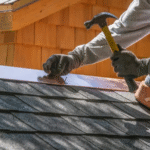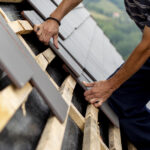Roof repair is often the first step homeowners take when dealing with leaks or damage, but a complete roof replacement is sometimes necessary. Replacing a roof is a significant investment whether due to aging, storm damage, or wear and tear. The cost of a roof replacement depends on various factors, including the roofing material, labor, and location. In this blog, we’ll explore the average costs, influencing factors, and ways to budget for a new roof.
Average Cost of Roof Replacement
The cost of replacing a roof varies widely based on the size and complexity of the project. On average, homeowners in the U.S. might anticipate spending $5,000 to $15,000 on a new roof. However, high-end materials and intricate roof designs can push costs beyond $30,000.
Cost Breakdown by Roofing Material
Different roofing materials have varying price points, affecting the overall roof replacement cost.
- Asphalt Shingles: $5,000 – $12,000 (Most affordable and common choice)
- Metal Roofing: $10,000 – $25,000 (Durable and energy-efficient)
- Tile Roofing: $15,000 – $30,000 (Aesthetic appeal with longevity)
- Flat Roofing: $8,000 – $16,000 (Used for commercial and modern residential roofs)
Additional Costs to Consider
Aside from material costs, roof replacement includes:
- Labor: $1.50 – $3.00 per square foot
- Old Roof Removal: $1,000 – $3,000
- Permits and Inspections: $100 – $500
- Structural Repairs: Varies based on damage severity
Factors Affecting Roof Replacement Costs
1. Roof Size and Complexity
Larger and more intricate roofs cost more because they require more time and materials. Steep slopes and multiple angles also make installation more labor-intensive.
2. Roofing Material Choice
Higher-end materials like slate and metal cost more upfront but last longer, while asphalt shingles remain the most budget-friendly.
3. Labor Costs
The cost of labor varies by region and roofing contractor expertise. Hiring licensed professionals ensures quality work but may cost more.
4. Roof Removal
If your old roof is in poor condition, removing and disposing of it adds to the total cost.
5. Weather and Location
Roofing costs fluctuate depending on location, climate, and demand for roofing services. Areas with extreme weather require more durable materials.
How to Save Money on Roof Replacement
- Compare Quotes: Get estimates from multiple contractors before making a decision.
- Choose Cost-Effective Materials: Asphalt shingles offer a balance of affordability and durability.
- Time It Right: Off-season roof replacements (late fall and winter) may be cheaper.
- Check for Insurance Coverage: If your roof is damaged by a storm, insurance may cover some costs.
- Consider Financing Options: Many roofing companies offer financing plans to ease the upfront cost.
Conclusion
A roof replacement is a significant investment, but understanding the costs and factors involved can help you budget effectively. Whether you choose asphalt, metal, tile, or flat roofing, hiring a professional ensures a long-lasting, durable roof. If you’re considering a roof replacement, Weather Proofing Roofing is here to help.
FAQs
1. What is the cheapest roofing material for replacement?
Asphalt shingles are the most affordable option. A typical roof replacement costs between $5,000 and $12,000.
2. How long does a roof replacement take?
A standard roof replacement typically takes 1 to 3 days, depending on the size and complexity of the project.
3. Does homeowners insurance cover roof replacement?
Insurance may cover roof replacement if the damage is due to covered perils like storms or fire. Normal wear and tear is not covered.
4. How can I tell if my roof needs replacement instead of repairs?
If your roof has extensive leaks, missing shingles, or is over 20 years old, replacement is often a better long-term solution than repairs.
5. Can I install a new roof over an old one?
In some cases, you can install new shingles over an existing roof, but it’s not always recommended as it may reduce longevity and hide structural issues.


